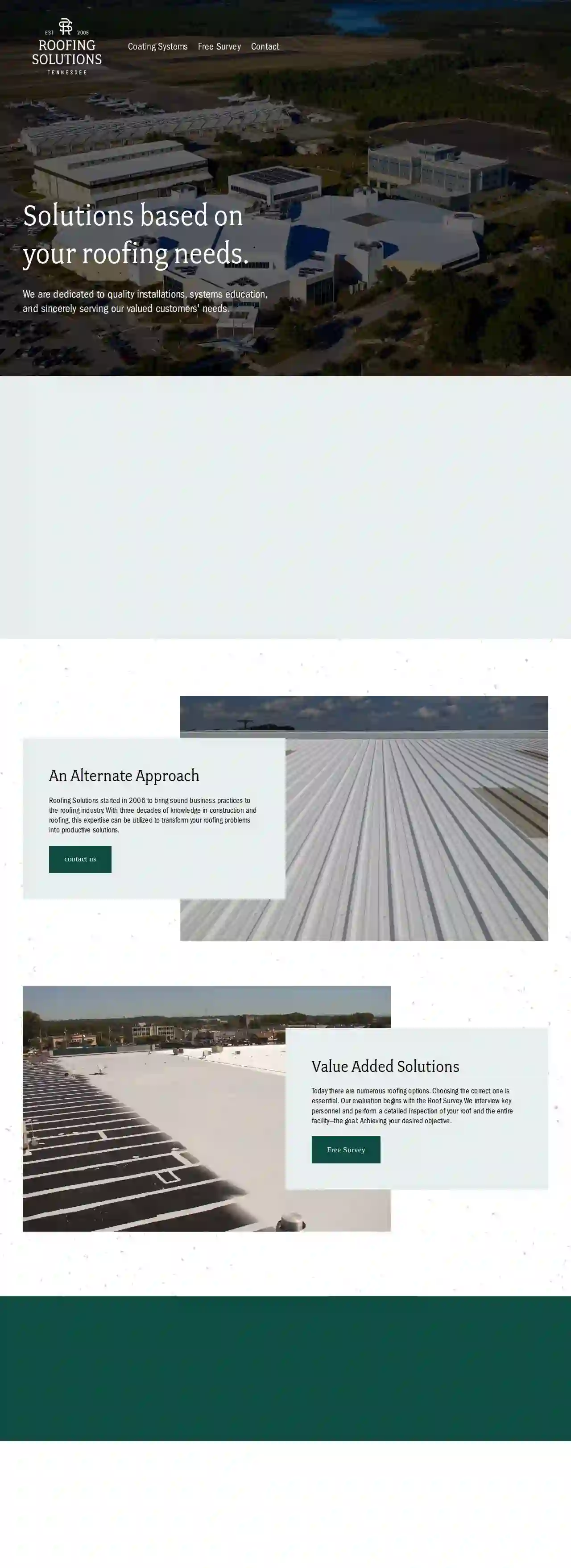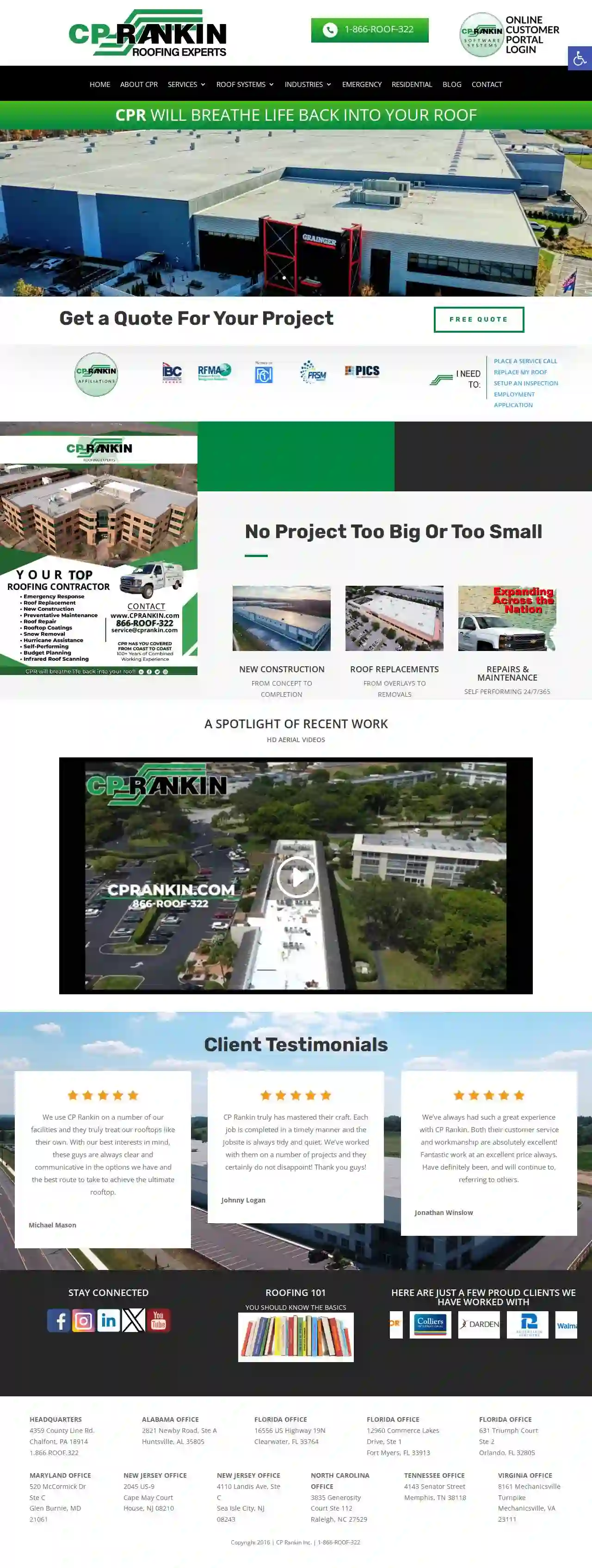Roofing Companies Munford
Find the best Roofing Companies in Munford
Receive 3 FREE Roofing Contractor quotes for your project today! Compare profiles, reviews, accreditations, portfolio, etc... and choose the best offer.

Roofing Solutions
706 Steeplechase Drive, Lebanon, 37090, USSolutions based on your roofing needs.We are dedicated to quality installations, systems education, and sincerely serving our valued customers' needs.We’re Your Roofing PartnerRoofing Solutions is a solutions-based commercial and industrial roofing business offering the highest quality Fluid Applied Membrane, or Coating Systems for Metal, Single-Ply and Asphalt Roofs. We are here to solve your roofing problems. We understand that your building is one of your most valuable financial assets, but we want to be your partner in how your roof functions for you.Learn moreAn Alternate ApproachRoofing Solutions started in 2006 to bring sound business practices to the roofing industry. With three decades of knowledge in construction and roofing, this expertise can be utilized to transform your roofing problems into productive solutions.
- Services
- Why Us?
- Gallery
Get Quote
ACS Commercial Roofing
4.715 reviews2 Charter Court, Unit 2, Johnson City, 37604, USThe ACS Roofing team strives to offer top-notch customer service. We exist to be knowledgeable, trusted partners, here to help you make the best decisions for your unique needs. Business roofing problems are business problems. We want to build a roof that is tailored to the needs of your business. We continue to study new innovations to ensure our clients don’t miss out on the best options for their property. We believe in ongoing education. Our account managers strive to understand all of the options available for any given property. We provide clients with visual inspection reports, thermal scans and more to convey problems and explain our solutions. Technology allows us to offer the value that clients expect, while offering competitively priced solutions. We have a culture of service. By empowering our employees and providing them with the tools they need to succeed, our clients benefit from a knowledgeable, passionate team. “People don’t buy what you do; they buy why you do it. And what you do simply proves what you believe.”— Simon Sinek
- Services
- Why Us?
- Our Team
- Gallery
Get Quote
TOPDOWN ROOFING
4.9142 reviews1319 Central Court, Hermitage, 37076, USTopDown Roofing is a family-owned business with over 10 years of experience in repairing and building quality roofs in the Greater Nashville area. We pride ourselves on providing top-notch work and having peace of mind with our 5-year labor warranty. Our goal is to make every homeowner happy by offering great customer service, quality results on all jobs, and warranties on our work.
- Services
- Why Us?
- Our Team
- Testimonials
- Gallery
Get Quote
Rackley Roofing
4.864 reviews105 Hunter Avenue, Carthage, 37030, USRackley Roofing installs commercial and industrial roofs to last. We also offer maintenance and repairs. We partner with you and consider your building’s needs and your budget. The materials our expert crews work with are: BUR – protection accomplished with layers of asphalt and fabrics, EPDM – harsh temperatures are no match for this rubber material, PVC – this single-ply membrane withstands UV and is resistant to punctures, Metal and Architectural Sheet Metal – an excellent option for aesthetics and longevity, Green Roofing and Paver Systems – an eco-friendly option for commercial and industrial building looker for a greener option. Our metal fabrication department allows us to customize metal to fit your needs. Metal can complement the looks or the performance of your building. Some options to consider are: Metal Canopies, Metal wall panels, Architectural sheet metal options. Since 1974, Rackley Roofing has operated with safety and superior customer service in mind. Knoxville, TN, is known for music and beautiful scenery, and Rackley Roofing is known as the leading industrial and commercial roofing contractor Knoxvillians trust. The roof of your commercial structure is vital to your livelihood. Our latest technological innovations, like Rackley RoofCheck and Rackley RoofView, help ensure we get an accurate assessment of your roof.
- Services
- Why Us?
- Gallery
Get Quote
CP Rankin Inc. - Roofing Experts
4.45 reviewsChalfont, PA, 4359 County Line Rd, 18914, USCPRankin is a roofing company that provides a wide range of services, including 24-hour emergency service, new construction, re-roofing, roof replacement, snow preparation, and more. With years of experience and a commitment to excellence, CPRankin has built a reputation for delivering high-quality results and exceptional customer service. The company is licensed in multiple states and has offices across the country. CPRankin's team of experts is dedicated to providing personalized attention to each client, ensuring that every project is completed to the highest standards. Whether you need a new roof or repairs, CPRankin is the perfect choice for all your roofing needs.
- Services
- Why Us?
- Accreditations
- Our Team
- Testimonials
- Gallery
Get Quote
No Limit Roofing
5130 reviews6094 Apple Tree Dr Suite 6, Memphis, 38115, USAt No Limit Roofing, we're your trusted partner in all things roofing, gutters, and exterior home improvement services. With over 15 years of collective experience under our belts, we've honed our craft to perfection, ensuring that every project we undertake is executed with precision and care. Your roof is more than just a covering; it's your first line of defense against the elements. That's why we take our responsibility to protect your home or business seriously. From minor repairs to complete replacements, our team of skilled professionals are equipped with knowledge and expertise to tackle any roofing challenge head-on. Transparency and honesty are the cornerstones of our business philosophy. When you choose No Limit Roofing, you can trust that we'll always shoot straight with you, providing clear and concise communication from start to finish. No surprises- just straightforward, reliable service you can count on. But don't just take our word for it- our satisfied customers speak for themselves. Brows our gallery to see examples of our work and read testimonials from homeowners and businesses who have experienced No Limit Roofing quality of standard firsthand. Ready to take the next step? Contact us today to schedule a consultation and discover how No Limit Roofing can help you protect your investment for years to come.
- Services
- Why Us?
- Gallery
Get Quote
Milliken's Roofing
4.627 reviewsNashville, USTrusted Excellence Roofing Beyond Expectations Seeking unparalleled roofing expertise? Located in Watertown, TN, Milliken’s Roofing is your go-to source for unmatched reliability and professionalism in the entire Middle Tennessee and the surrounding areas. Dive into a legacy of quality and customer satisfaction that sets us apart. Let’s connect and elevate your roofing experience. Reliable Roofing Contractors in Watertown, TN, Serving Middle Tennessee, Nashville TN, and the Surrounding Areas Dealing with roofing issues can be stressful and inconvenient, often disrupting your daily routine. Recognizing this, Milliken’s Roofing steps in as your dedicated solution provider. Established in Watertown, TN, we proudly serve in Middle Tennessee, Nashville, TN, and the surrounding areas. Our roots in the roofing industry run deep, with a legacy spanning three generations. Our commitment to honesty and transparent communication sets us apart, allowing us to understand and meet your needs effectively. By choosing us, you’re not just hiring a contractor; you’re partnering with a family business that values integrity above all. We specialize in a range of roofing services tailored to address every aspect of your roofing problems, from shingle roofing, metal roofing, roofing soft wash, EPDM & TPO roofing, to insurance work, offering peace of mind and satisfaction as we restore the comfort and safety of your home. Work With Us (615) 971-6556 [email protected] Watertown, TN Why Choose Us? Quality Roofing With a Personal Touch If you are anywhere in Nashville, TN, Middle Tennessee, or the surrounding areas, choose Milliken’s Roofing for a roofing experience that combines quality, reliability, and a personal touch. Our deep roots in Watertown, TN, reflect a tradition of excellence and trust. With over three decades of personal experience, we understand roofing inside out. Our comprehensive services are designed to meet your specific needs. We prioritize your satisfaction, ensuring we don’t rest until you’re completely happy with our work. Expert Experience Guaranteed! Comprehensive Roofing Services Tailored for You Milliken’s Roofing offers a wide array of services to cater to all your roofing needs. From the durability of metal roofing to the precision of shingle repair, we’ve got you covered. Our roofing soft wash extends the life of your roof, maintaining its aesthetic and functional value. For those seeking modern solutions, our EPDM & TPO roofing options offer advanced protection. We also specialize in navigating roof insurance claims, ensuring you get the support you need after storm damage. Trusted Expertise, Lasting Solutions Milliken’s Roofing is synonymous with reliability and quality. With a deep-rooted history in roofing and a commitment to excellence, we’re the team you can trust. Dive deeper to discover why we stand out.
- Services
- Why Us?
- Gallery
Get Quote
Cornerstone Construction Services, Inc.
4.910 reviews10609 Lexington Dr., Knoxville, 37932, USCornerstone Construction Services, Inc. is a general contractor who works on all roofing types in the Knoxville, TN area. Hiring a certified roofing professional is easy. Contact us for more information, check out our Cornerstone Construction Services, Inc. brochure. We combine customer service with years of expertise. As the premier roofing contractor in Knoxville, TN, we've been in business for over 30 years. With our reputation for quality work, many of our clients find us through word-of-mouth. We only allow the most reliable and skilled contractors to join our team. You can count on us to do the job right the first time, every time. To learn more about any of our roofing services, call us now.
- Services
- Why Us?
- Accreditations
- Our Team
- Testimonials
- Gallery
Get Quote
Superior Roofing
585 reviewsFranklin, USEstablished in Middle Tennessee, Superior Roofing LLC is a local roofer Franklin TN that specializes in residential and commercial new roofs, roof replacements, and roof leak repairs. With over 20 years of experience and roofing knowledge, Superior Roofing, LLC is building a strong reputation by consistently providing professional, high-quality roofing solutions. Superior Roofing, LLC is emerging as a leader in all types of roof construction and installation using superior roofing systems.
- Services
- Why Us?
- Accreditations
- Testimonials
- Gallery
Get Quote
MHM ROOFING
513 reviews123 Main St, Los Angeles, 90210, USMHM Roofing is a family-owned and operated roofing company serving the greater [City] area. We are committed to providing our customers with the highest quality roofing services at competitive prices. Our team of experienced roofers has the knowledge and expertise to handle all of your roofing needs, from small repairs to complete roof replacements. We use only the best materials and workmanship to ensure that your roof is built to last.
- Services
- Why Us?
Get Quote
Over 17,196+ Roofing Companies on our directory
Our roofing contractors operate in Munford and surrounding areas!
Roofyng.com has curated and vetted Top Roofers near Munford. Find a reliable contractor today.
Frequently Asked Questions About Roofing Companies
- Sagging or Pulling Away: Gutters that are sagging, pulling away from the house, or visibly damaged need repairs or replacement.
- Overflowing Water: If water overflows during rain, it indicates clogs or inadequate drainage.
- Visible Debris: Leaves, twigs, and other debris accumulated in the gutters obstruct water flow.
- Water Damage: Water stains or damage to siding or foundation near the gutters suggest overflow.
- Plant Growth: Plants or moss growing in the gutters indicate standing water and the need for cleaning.
- Ventilation: Soffit vents provide intake ventilation, allowing fresh air to enter the attic and regulate temperature and moisture.
- Aesthetics: It creates a finished look to the roof's underside.
- Pest Control: A properly sealed soffit prevents pests like birds and squirrels from nesting in the attic.
- Roof size and complexity
- Roofing material chosen
- Local labor costs
- Accessibility of the roof
- Removal of existing roofing
- Additional features (skylights, chimneys, etc.)
How can I tell if my gutters need to be cleaned or repaired?
What is a soffit, and why is it important for my roof?
What is fascia, and why is it important?
How much does a new roof cost in the USA?
How can I tell if my gutters need to be cleaned or repaired?
- Sagging or Pulling Away: Gutters that are sagging, pulling away from the house, or visibly damaged need repairs or replacement.
- Overflowing Water: If water overflows during rain, it indicates clogs or inadequate drainage.
- Visible Debris: Leaves, twigs, and other debris accumulated in the gutters obstruct water flow.
- Water Damage: Water stains or damage to siding or foundation near the gutters suggest overflow.
- Plant Growth: Plants or moss growing in the gutters indicate standing water and the need for cleaning.
What is a soffit, and why is it important for my roof?
- Ventilation: Soffit vents provide intake ventilation, allowing fresh air to enter the attic and regulate temperature and moisture.
- Aesthetics: It creates a finished look to the roof's underside.
- Pest Control: A properly sealed soffit prevents pests like birds and squirrels from nesting in the attic.
What is fascia, and why is it important?
How much does a new roof cost in the USA?
- Roof size and complexity
- Roofing material chosen
- Local labor costs
- Accessibility of the roof
- Removal of existing roofing
- Additional features (skylights, chimneys, etc.)